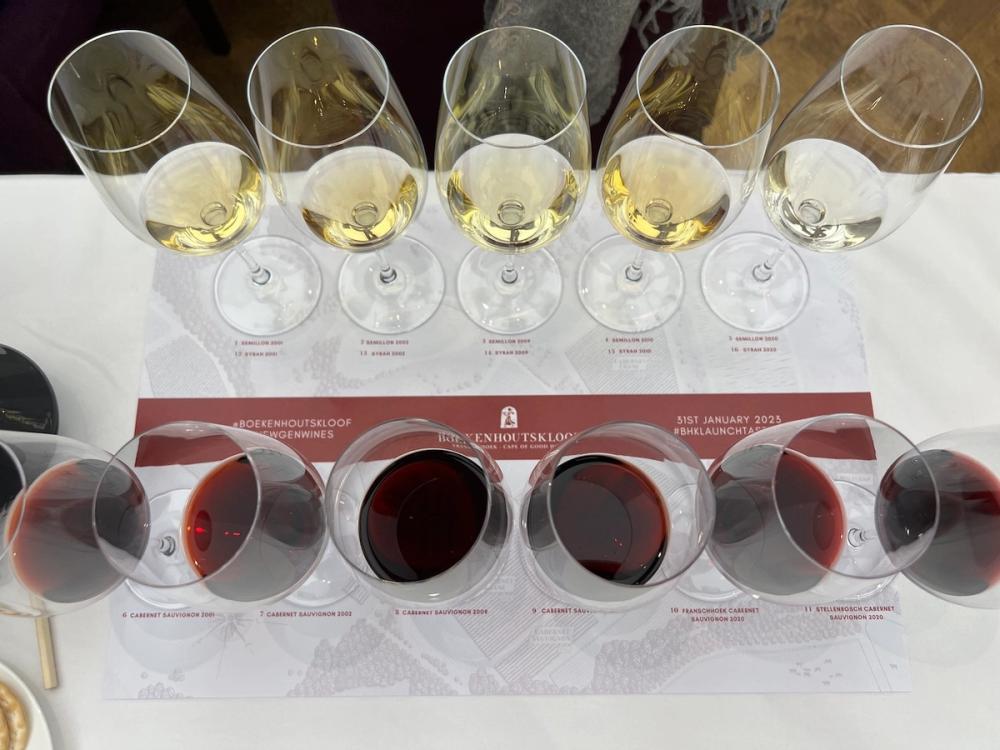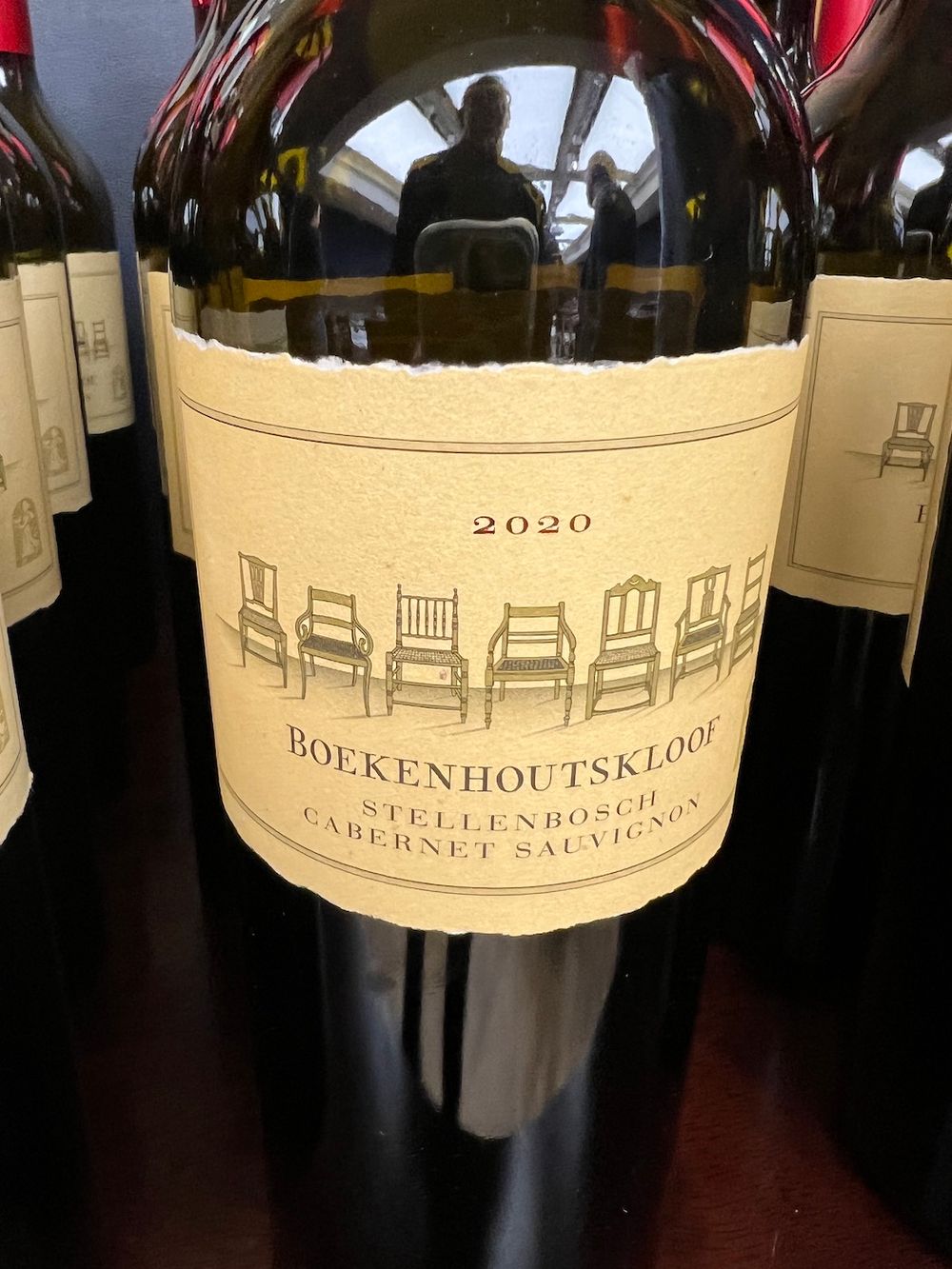The entire range of the Boekenhoutskloof 2020 wines show this South African estate growing from strength to strength.

Marc Kent, Boekenhoutskloof 2020 tasting, London, 2023
Marc Kent jokes that he’s such a bad viticulturist that he can’t even grow cannabis. Peppering a tasting of his new Boekenhoutskloof 2020 wines with whimsical asides (as is his wont) he says: “My kids came up to me and said you know those two dope plants you were growing out the back, they’ve died. They’re called weeds for a reason Dad.”
Kent is jesting, for sure – over the past 27 years with his Boekenhoutskloof, Chocolate Block and Porcupine Ridge wines he has more than demonstrated his chops for making standout mass market wines and those aimed at connoisseurs but, in Gottfried Mocke, Kent has now got a highly skilled chief winemaker who, if the 2020 wines are anything to go by is taking the Franschhoek Valley-based winery to even greater heights.

New heights: Gottfried Mocke, chief winemaker at Boekenhoutskloof
Since Mocke joined Boekenhoutskloof in 2015 the wines have gained a technical precision and consistency that was plainly evident during this excellent tasting of the estate’s Semillon, Cabernet Sauvignon and Syrah across five vintages. A great fan of these wines and ones which I buy in most vintages I can honestly say that in the 2020 wines I have not tried better Semillon and Syrah from BHK, (the Cabernet Sauvignon 2020 only being pipped to top spot by the magnificent 2009 in a comparative tasting).
Mocke is the third winemaker at Boekenhoutskloof since 2001, helping Kent expand even more from the 6,000 bottles he produced in 1996 to the 7.5 million bottles produced from 6 properties across four different regions of South Africa.
Before we started the tasting, Kent explained that we were tasting the 2001, 2002, 2009 and 2010 vintages of all the estate’s flagship wines to give the new 2020 vintage some context, but also display the estate’s philosophy on allowing the vintages to show themselves in this range of wines.
Tasting four vintages of Semillon

Boekenhoutskloof Semillon 2020
13.5% ABV, TA 5.4 g/l, pH 3.41, RS 2 g/l
This 24th vintage is outstanding in youth and augurs well for considerable ageing potential.
The fruit is from three very old vineyards in Franschoek (20% from 121- year-old vines) with 2% early-picked Muscat d’Alexandrie also from 1902 planted vines, added to the mix. The old vine Semillon lacks the pyrazines associated with New World Semillon. The fruit is whole bunch-pressed, fermented in barriques and concrete eggs and matured for 14 months (70% oak and 30% eggs) in an oxidative style at low temperatures. This technique is used to bring out the textural components of the Semillon. The Muscat is made in clay amphora and added to enhance aromatics.
Aqueous in appearance. The aromatics are complex and have a herbal quality – think lemongrass rather than Sicilian lemon – honeysuckle, lanolin with a hint of smoky reduction. In the mouth the wine has considerable poise, at first welcoming, open and fresh, but also balanced and layered. It sits on the palate just so. Textural too, precise, clean with linear acidity that persists through the incredible lengthy finish. Superb fine wine with many gastronomic possibilities.
The tasting of the new Semillon 2020 was prefaced by two pairs of library Semillon vintages – 2001 & 2 and 2009 & 10

Boekenhoutskloof Semillon 2001
Boekenhoutskloof Semillon 2002
2001 marked the first vintage that two younger, low-yielding vineyards were used to source fruit from in addition to the 1902 block. The 01 and 02 both had 8% Sauvignon Blanc added to “lift the tail of the wine”.
The 2001 is medium gold – the colour and intense yellow stone fruit reflecting the ripeness of the vintage. The wine is ripe, generous, oleaginous with a fruit syrup note in the aromatics with gorgeous flavours of yellow peach, nectarine and a touch of nutshell. The best of the library wines.
2002 was a “crap vintage” with lots of rain. Being whole bunch-pressed without sulphur results in a white Rioja style – less complex on the nose, maderised, with nutty notes and more apparent wood on the palate. Fresh and light still in the mouth, less ‘oily’.
Boekenhoutskloof Semillon 2009
Boekenhoutskloof Semillon 2010
The 2009 and 2010 both still use Sauvignon Blanc (8 and 11%) in the mix. Temperatures in the cold room were dropped significantly to inhibit malolactic fermentation and minimse oak extraction. SB was added and then the wine bottled for a further 15 months.
2009 was a “super-easy, a lovely vintage that helped us get Winery of the Year in 2011/2,” says Kent. Light-medium gold the aromatics have lemongrass and lanolin with less orchard fruit. Fruit profile on the palate is gorgeous, fresh and clean, with a good balance between the acidity and the richness of the vintage. The winery had just started using eggs which comes through on the palate weight and vinosity of the wine.
The team struggled to find ripeness in 2010. The colour is deep gold on account of the extra rot and is disolated in the mouth – feeling both very evolved and vigorous at the same time. My least favourite of the flight.
In order of preference I rated the Semillon in the following order:
2020/ 2001/ 2009/ 2002/ 2010
Tasting four vintages of Cabernet Sauvignon

Boekenhoutskloof Franschhoek Cabernet Sauvignon 2020
14.5% ABV, TA 5.2 g/l, pH 3.87, RS 2.8 g/l
No longer blended together, the fruit for this Cab Sav comes entirely now from four parcels on the poor soils of the south-west slopes of the Franschhoek Valley. Since 2015 Gottfried Mocke has reduced the amount of new oak used for ageing (now 80% in light toast barriques for 22 months) and insisted on shorter elevage.
For the 2020 vintage more Cabernet Franc than usual has been used in the blend (14%) which gives the wine a leafy freshness and has helped balance the ripeness of the 2020 vintage. Aromatically the wine is classic Cab with ripe, intense cassis, graphite and violets with a hint of milk chocolate, in the mouth the wine is textural, tense between the ripe berry fruit and dry core, flavours of red pepper, herbs, crunchy blackcurrants. A tight dry finish. Lovely fruit expression, great balance and obviously needs more ageing.

Boekenhoutskloof Stellenbosch Cabernet Sauvignon 2020
14.5% ABV, TA 5.2 g/l, pH 3.93, RS 3.4 g/l
Less Cab Franc than the previous wine (4%) and just 65% new oak, the Stellenbosch 2020 is made entirely with fruit from the Helderberg mountain.
A serious piece of kit. Riper, more intense, with more brooding breadth than its sibling. The Cab Franc makes its presence felt on the more complex nose which has ripe black fruit, hints of charcoal, vanilla and fire hearth. Huge power and concentration in the mouth, slightly greener than the Franschhoek. A massive-boned wine – mouth-puckeringly dry. Less elegance than the 2019 but massive potential. I would leave this for 5 years at least.
The tasting of the new Cabernet Sauvignon 2020 was prefaced by two pairs of library Cabernet Sauvignon vintages from the same years as all the other back vintage wines – 2001 & 2 and 2009 & 10
Boekenhoutskloof Cabernet Sauvignon 2001
Boekenhoutskloof Cabernet Sauvignon 2002
Both vintages featured 100% Cabernet Sauvignon sourced from the original site of the wine’s first vintage and the vineyards that form the backbone of the estate’s Franschhoek wine
The 2001 is highly evolved colour-wise, blood red with bricking on the edge. There’s a lovely minty eucalyptus character on the nose, mulberry blackberry, and a hint of antiseptic. In the mouth the wine has amazing power and intensity, nicely balanced though with very fine-boned tannins and linear acidity suggesting this could last another decade.
The 2002 felt more New World in character. The appearance is ruddy, with bricking on the edge. Aromatics are more primary than ‘01, intense ripe fruit – cassis, blackberry jelly. Massive length and concentration with a slight greenness on the back palate.
Boekenhoutskloof Cabernet Sauvignon 2009
Boekenhoutskloof Cabernet Sauvignon 2010
The fruit-sourcing and the winemaking on the 09 and 10 are the same as 01 and 02 except for the addition of 11% Cabernet Franc which the estate introduced into the mix from 2003.
The 09 was possibly my wine of the tasting. Ox blood red, it had candy tobacco and cigar wrapper on the nose, in the mouth the wine was so full of life – amazingly so – with silky, powdery-fine tannins framing beautifully aged fruit. So fresh and vivacious. Wow! What a wine.
2010 was a lesser Cab vintage and the greater amount of pumpover shows in a more New World extraction. Like a lesser version of 2009 it’s got much more texture – high acidity and very dry. Still this has some fine elegance and is quite delicate.
In order of preference I rated the Cabernet Sauvignon in the following order:
2009/ 2020 Franschhoek/ 2020 Stellenbosch/ 2010/ 2001/ 2002
Tasting four vintages of Syrah

Boekenhoutskloof Syrah 2020
14% ABV, TA 5.00 g/l, pH 3.87, RS 1.9 g/l
Kent reckons this is the best Syrah that Gottfried Mocke has made to date and who are we to argue? This is a stunning Northern Rhône style Syrah, the sixth vintage made with fruit hailing from Swartland where, in this vintage, 88% of the fruit comes from Porseleinberg and 12% Goldmine. Each parcel is vinified separately using 60% whole bunch and maturation takes place over 18 months in large, old oak formats as oppose to the 27 months maturation the library wines we tasted had undergone.
As for the tasting. Gorgeous aromatics develop in the glass with black fruit, fynbos, a smoky/ spicy note and pressed flowers. In the mouth the wine is pure, clean and elegant; this is a medium-bodied wine with a good deal of tension and freshness. Lively acidity, textural with fine satin tannins and a sappy grip. I found a dusting of cocoa powder. This one should run and run.
The tasting of the new Boekenhoutskloof Syrah 2020 was prefaced by two pairs of library Syrah vintages – 2001 & 2 and 2009 & 10

Boekenhoutskloof Syrah 2001
Boekenhoutskloof Syrah 2002
Although Kent dismisses some of the negative comments about the alcohol level (15.1% ABV) on account of this vintage dictating it, there is no doubt it does play a major part on the palate. For sure, there is a nice line of acidity keeping the component parts together but it is very ripe indeed, ox blood in colour with huge extraction. My least favourite.
The 2002, even though it is not far behind with 14.81% ABV, feels much better balanced – fantastically fresh, finer, more elegant with an attractive ripeness – the difference a ‘crap’ vintage makes!
Boekenhoutskloof Syrah 2009
Boekenhoutskloof Syrah 2010
The wine was made in a different style with cold soak, some whole bunch and vinifying in concrete before ageing in barriques. Because Kent picks the fruit when the grapes just start to wrinkle (‘old man’s face’), in an excellent vintage like 2009 was, the fruit gets there quicker and the alcohol is therefore not as chunky (13.6% ABV) as you tend to find in a poorer vintage.
Ripe blackberries, fynbos and five-spice notes dominate on the nose in the 2009, in the mouth the wine is gorgeously fresh, a tad reserved, but elegant with terrific balance. Superb wine.
Although 2010 is lovely and fresh on the palate, it is noticeably New World with jammy extraction – a blackberry confiture note – and there is a disjointed feel about the wine: intense, ripe, sweet aromatics, dry stone texture with a very dry finish.
In order of preference I rated the Syrah in the following order:
2020/ 2009/ 2002/ 2010/ 2001
Boekenhoutskloof wines are imported and sold in the UK through New Generation Wines – a commercial partner of The Buyer.









































